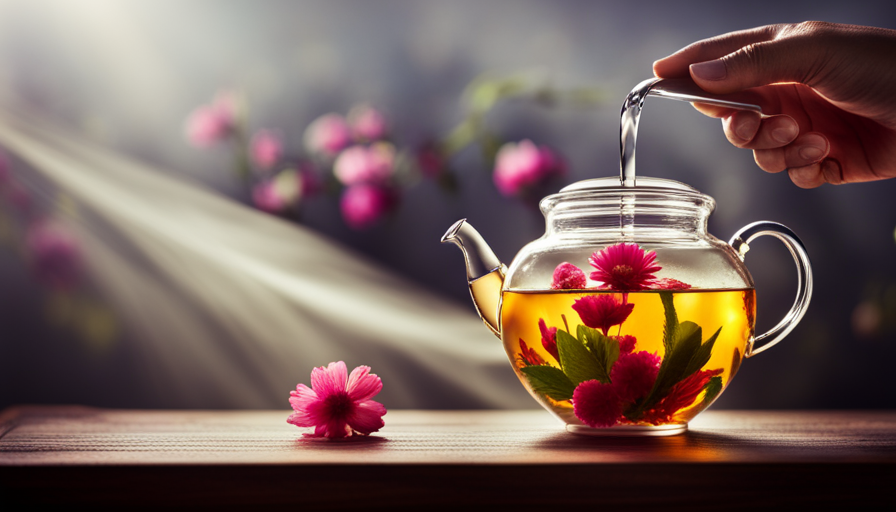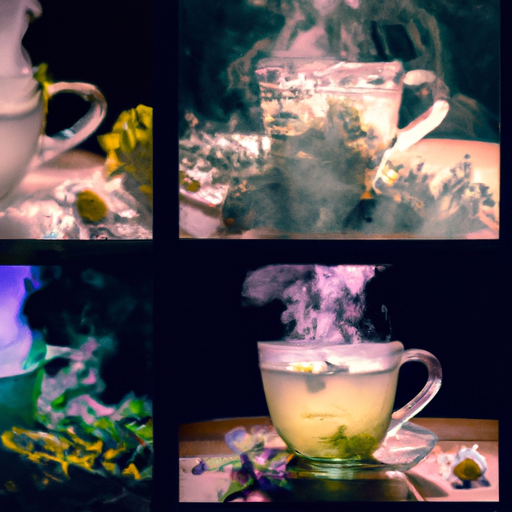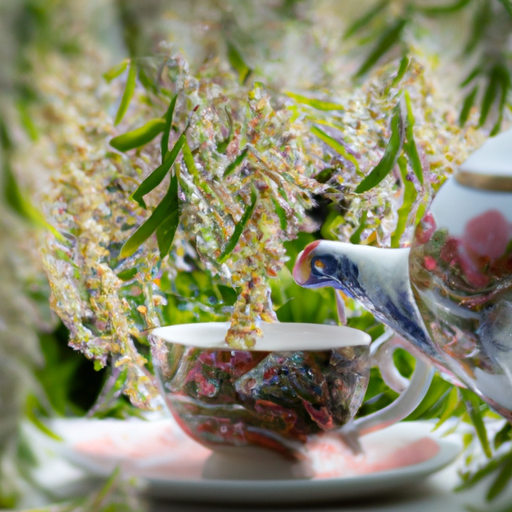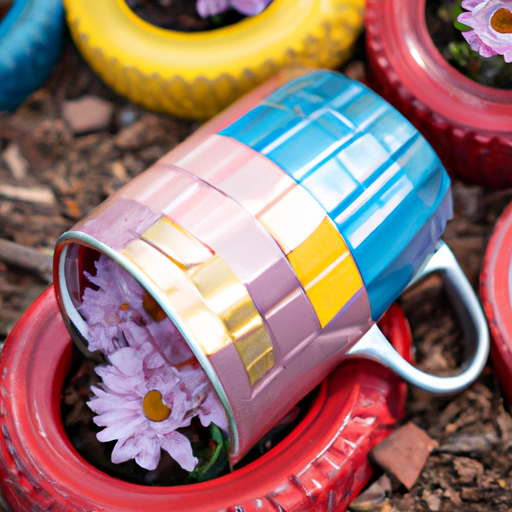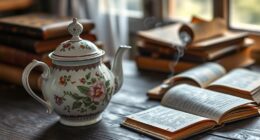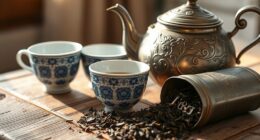Are you under the impression that brewing tea is simply a matter of boiling water and adding a tea bag? Get ready to be amazed, my friend. Today, I will be showcasing the exquisite art of crafting flower tea.
Yes, you heard me right – tea made from flowers. And let me tell you, it’s not just a pretty face. With its delicate flavors and soothing aromas, flower tea is a whole new level of tea experience.
In this article, I’ll guide you through the process of making flower tea step by step. We’ll start by choosing the perfect combination of flowers and herbs, because let’s face it – not all flowers are created equal when it comes to tea.
Then, I’ll show you how to prepare your tea infuser or teapot, because brewing flower tea requires a bit of finesse. From boiling water to pouring it over the flowers and herbs, I’ll walk you through each and every detail.
And of course, I’ll share some tips on how to sweeten and flavor your tea, because who doesn’t love a little extra touch of deliciousness?
So get ready to embark on this floral tea adventure with me. By the end of this article, you’ll be a flower tea aficionado, impressing your friends and family with your newfound tea mastery.
Let’s dive in and discover the wonders of flower tea together.
Key Takeaways
- Choosing the right combination of flowers and herbs is crucial in making flower tea.
- Properly drying and preserving flowers is important for making high-quality flower tea.
- Tea infusers and teapots are essential tools for steeping loose flower tea.
- Controlling water temperature and level ensures optimal taste and health benefits when making flower tea.
Choose Your Flowers and Herbs
Now, it’s time for you to choose your favorite flowers and herbs to create a vibrant and aromatic blend for your flower tea.
Different types of flowers offer unique health benefits and flavors, allowing you to customize your tea to suit your specific needs.
For a calming effect, chamomile flowers are an excellent choice, known for their ability to reduce anxiety and promote better sleep.
If you’re looking to boost your immune system, consider adding elderflower to your blend, as it’s packed with antioxidants.
Rose petals not only provide a delicate floral taste but also offer anti-inflammatory properties.
To ensure the freshness of your flowers, it’s important to properly dry and preserve them. Begin by harvesting the flowers in the morning when the dew has evaporated. Hang them upside down in a cool, dry place, away from direct sunlight. Once dried, store them in an airtight container to maintain their potency.
Now that you have your flowers ready, let’s move on to preparing your tea infuser or teapot for brewing.
Prepare Your Tea Infuser or Teapot
When preparing your tea, it’s important to have the right tools on hand. For loose tea, a tea infuser is essential. This allows the tea leaves to steep freely, ensuring a full-bodied flavor.
On the other hand, if you prefer the convenience of tea bags, a teapot is the perfect vessel to infuse the flavors into the hot water. Just remember to choose the right tools based on your preferred type of tea!
Use a Tea Infuser for Loose Tea
To truly savor the delicate flavors of loose tea, let the tea infuser work its magic and transport you to a world of fragrant blossoms and soothing sips. Using a tea infuser for loose tea offers several advantages over using a teapot.
First, the infuser allows the tea leaves to fully expand and infuse the water, resulting in a more flavorful and aromatic cup of tea.
Second, the fine mesh of the infuser prevents any tea leaves from escaping into your cup, ensuring a smooth and enjoyable drinking experience.
Third, the infuser is easy to clean, making it a convenient choice for tea enthusiasts.
Lastly, using loose tea allows you to explore a wide variety of flavors and blends, which isn’t always possible with pre-packaged tea bags.
Now, let’s move on to the next section and learn how to choose a teapot for tea bags.
Choose a Teapot for Tea Bags
If you’re a fan of the convenience of tea bags, choosing a teapot that accommodates them can enhance your tea-drinking experience. For example, imagine having a teapot with a built-in infuser that allows you to easily steep and remove your tea bags, resulting in a hassle-free and enjoyable cup of tea every time.
The pros of using a teapot for tea bags are numerous. Firstly, it provides a more elegant and traditional way of serving tea. Secondly, it allows for better control of the steeping time, ensuring a perfect cup of tea with no bitterness.
However, there are a few cons to consider as well. Tea bags may not fit properly in all teapots, and there is a risk of oversteeping if the tea bags are not removed promptly.
There are different types of teapots designed specifically for brewing tea bags, such as ceramic or glass teapots with a removable infuser basket. These teapots offer the convenience of easy removal and disposal of tea bags.
Transitioning into the next section about boiling water, it’s essential to use properly heated water to achieve optimal tea flavor.
Boil Water
First, boil some water to make the flower tea. Boiling water is a crucial step in preparing a flavorful and aromatic cup of tea. To ensure the best taste and quality, it’s important to use the right boiling techniques and maintain proper temperature control.
Here’s how you can do it:
-
Choose a high-quality source of water, such as filtered or spring water, to enhance the taste of your tea.
-
Fill a kettle or pot with the desired amount of water, making sure not to overfill it.
-
Place the kettle or pot on a stove or heat source and turn it on to high heat.
-
As the water heats up, monitor the temperature using a thermometer. For flower tea, the ideal temperature is between 180-200°F (82-93°C) to preserve the delicate flavors.
By boiling the water to the appropriate temperature, you can unlock the full potential of the flowers and herbs used in the tea. Once the water is heated, you can proceed to the next step of adding flowers and herbs to the infuser or teapot, infusing your tea with delightful flavors and aromas.
Add Flowers and Herbs to the Infuser or Teapot
Now, it’s time to add a beautiful array of fragrant flowers and aromatic herbs to your infuser or teapot, allowing their vibrant colors and enticing scents to infuse your cup of tea. Adding flowers and herbs to your tea not only enhances its visual appeal but also brings a myriad of health benefits. These natural ingredients are packed with antioxidants, vitamins, and minerals that can support digestion, boost the immune system, and promote relaxation.
When choosing flowers and herbs for your tea, it’s important to consider their flavors and medicinal properties. For a soothing and calming tea, chamomile flowers and lavender buds are excellent choices. If you’re looking for a refreshing and invigorating blend, try adding hibiscus petals and mint leaves. Each combination offers a unique taste profile and therapeutic effects.
To make the brewing process easier, there are various types of tea infusers and teapots available. Tea infusers come in different shapes and sizes, from traditional stainless steel mesh balls to fine mesh baskets and silicone tea bags. Teapots, on the other hand, provide a larger space to infuse the flowers and herbs, allowing for a more potent flavor extraction.
Now that your infuser or teapot is ready with flowers and herbs, it’s time to pour hot water over them, extracting their essence and creating a delightful infusion.
Pour Hot Water Over the Flowers and Herbs
To make the perfect flower tea, it’s crucial to pour the hot water slowly and steadily over the flowers and herbs. This ensures that the flavors and aromatic compounds are extracted gradually, resulting in a more balanced and flavorful brew.
Additionally, it’s important to fill the infuser or teapot to the desired level, taking into consideration the desired strength of the tea and the recommended steeping time. This allows for a consistent and controlled infusion, ensuring optimal taste and therapeutic benefits.
Pour the Water Slowly and Steadily
As you pour the water into the teapot, feel the anticipation build as the delicate petals unfurl, releasing their fragrant essence. The key to pouring the water over the flowers and herbs is to do it slowly and steadily. This allows the water to interact with the petals and herbs, extracting their flavors and aromas.
To control the water temperature, you can use a thermometer or simply let the boiled water cool for a few minutes before pouring. Another way to control the temperature is by using filtered water, which eliminates any impurities that might affect the taste of the tea. Using filtered water also enhances the health benefits of the flower tea, as it ensures a clean and pure infusion.
So, pour the water slowly and steadily, allowing it to mingle with the flowers and herbs, and prepare for the next step of filling the infuser or teapot to the desired level.
Fill the Infuser or Teapot to the Desired Level
When you fill the infuser or teapot to the desired level, you’ll be amazed at the beautiful colors swirling together, creating a mesmerizing blend that will transport you to a tranquil oasis.
Choosing between an infuser and a teapot for making flower tea depends on personal preference. An infuser is a small, perforated container that holds the tea leaves, while a teapot is a larger vessel that allows the tea to steep freely. For flower tea, both options work well, but an infuser may be better if you prefer a more controlled infusion.
To achieve the perfect tea to water ratio, a general guideline is to use one teaspoon of dried flower petals or one flower blossom per cup of water. Adjust the amount of flowers based on your taste preference.
Once you’ve achieved the desired level, it’s time to steep the tea and unlock its full flavor potential.
Steep the Tea
Start steeping the tea and watch as the flavors explode with each passing second. Steeping is an essential step in making flower tea, as it allows the flavors and nutrients to infuse into the hot water.
Different steeping techniques can be employed depending on the type of flower tea you’re using. For delicate flowers like chamomile or lavender, it’s recommended to gently steep them. Simply pour hot water over the flowers and let them steep for about 3-5 minutes. This’ll ensure that the delicate flavors aren’t overwhelmed or bitter.
For stronger flowers like hibiscus or rose, a longer steeping time of about 5-7 minutes is ideal. This allows the full-bodied flavors to develop and create a richer tea experience.
As the tea steeps, it releases its natural antioxidants, vitamins, and minerals, providing numerous health benefits. These include improving digestion, boosting the immune system, and reducing stress.
Once the tea has steeped to perfection, it’s time to strain the tea, separating the infused liquid from the flowers. This ensures a smooth and enjoyable tea experience, free from any loose petals or debris.
Strain the Tea
After steeping the tea leaves, it’s time to strain the tea. This step is crucial to remove any solid particles and ensure a smooth and enjoyable flower tea experience. Straining the tea also allows the flavors to fully develop and enhances the overall taste.
To strain the tea, you have several options to choose from. Here are five different ways to strain your flower tea:
- Fine mesh strainer: This is the most common and widely used method. It effectively removes any small particles while allowing the liquid to flow through smoothly.
- Tea infuser: Ideal for loose tea leaves, a tea infuser is a small ball or mesh container that holds the leaves while the tea steeps. It can be easily removed, leaving behind a perfectly strained tea.
- Cheesecloth: If you prefer a more rustic approach, a cheesecloth can be used to strain the tea. Simply pour the tea through the cloth and let it filter out any solids.
- Coffee filter: Similar to a tea infuser, a coffee filter can be used to strain the tea leaves. It’s a convenient option if you don’t have any specialized tea strainers on hand.
- French press: Although primarily used for coffee, a French press can also be repurposed as a tea strainer. The plunger effectively separates the liquid from the tea leaves.
Now that the tea is strained, it’s time to move on to the next step: sweeten and flavor your tea (optional). By adding a touch of sweetness or a hint of flavor, you can elevate the taste of your flower tea and create a truly delightful beverage.
Sweeten and Flavor Your Tea (Optional)
Enhance your floral infusion by adding a touch of sweetness or a hint of flavor to elevate your tea experience. Sweetening options for flower tea range from traditional sugar to more natural alternatives like honey or stevia. Each option offers a unique taste profile, so experiment and find the one that best complements the delicate flavors of your chosen flowers. If you prefer a sweeter tea, start with a small amount of sweetener and gradually add more until you achieve your desired taste.
Flavoring alternatives can take your flower tea to the next level. Consider adding a slice of lemon or orange for a citrusy twist, or a sprig of mint for a refreshing burst of flavor. You can also experiment with other herbs and spices like lavender, chamomile, or cinnamon to create a more complex and aromatic blend.
To help you choose the perfect sweetener and flavor combination for your flower tea, refer to the table below:
| Sweetener | Flavor Profile | Best Flower Pairing |
|---|---|---|
| Sugar | Classic, sweet | Rose, hibiscus |
| Honey | Rich, floral | Jasmine, lavender |
| Stevia | Natural, subtle | Chamomile, elderflower |
By sweetening and flavoring your tea, you can customize it to suit your taste preferences. Now, let’s move on to the next section to learn how to serve and enjoy your delightful cup of flower tea.
Serve and Enjoy
To serve and enjoy your flower tea, carefully pour the brewed tea into cups or mugs, making sure to strain out any loose petals or herbs.
The aroma of the tea will be enhanced if you garnish each cup with a sprig of fresh flowers or herbs. This not only adds a visually pleasing touch, but also imparts a subtle flavor and fragrance to the tea.
Pour the Tea into Cups or Mugs
Pour the tea into your favorite cups or mugs and savor the delicate flavors of the flower infusion. When it comes to presenting flower tea, there are different ways to enhance the visual appeal of your brew.
One option is to use transparent glass cups or mugs, which allow you to appreciate the beautiful colors and shapes of the flowers floating in the tea. Another idea is to use ceramic cups or mugs with intricate floral designs, which complement the floral theme of the tea. Additionally, using cups or mugs with a wide rim can enhance the aroma of the tea and allow you to fully experience its fragrance.
By choosing the right cups or mugs, you can elevate your flower tea experience to a whole new level.
Now, let’s move on to the next section and explore how to garnish your tea with fresh flowers or herbs.
Garnish with Fresh Flowers or Herbs
Add a pop of color and a touch of freshness to your brew by garnishing with vibrant, fragrant flowers or aromatic herbs. Not only do they enhance the visual appeal of your flower tea, but they also add a delightful aroma and taste.
When it comes to garnishing, there are endless possibilities. Here are a few ideas to get you started:
- Sprinkle dried rose petals on top for a delicate floral flavor.
- Use lavender buds to infuse a calming and soothing aroma.
- Add a sprig of mint for a refreshing and invigorating twist.
- Experiment with chamomile flowers to create a soothing and relaxing blend.
Incorporating fresh flowers and herbs not only enhances the taste and aroma of your flower tea but also provides numerous health benefits. Flowers like roses and lavender have calming properties, while herbs like mint and chamomile aid in digestion and relieve stress.
So go ahead, get creative with your garnishes, and experiment with different flower combinations to find your perfect brew.
Experiment with Different Flower Combinations
By mixing various combinations of flowers, you’ll be amazed at the delightful flavors and enchanting aromas that can be created in your flower tea. Experimenting with different flower combinations not only adds complexity to the taste, but also enhances the health benefits of your tea.
Each flower brings its unique properties, creating a harmonious blend that is both delicious and beneficial for your well-being.
When it comes to flower tea, the possibilities are endless. Try combining lavender and chamomile for a calming and soothing brew, perfect for relaxation after a long day.
For a refreshing and rejuvenating blend, mix hibiscus and rose petals. This combination not only provides a burst of floral flavors but is also rich in antioxidants, promoting a healthy immune system.
If you’re looking for a floral tea with a hint of sweetness, try infusing jasmine and elderflower together. This combination offers a delicate and fragrant taste, making it a delightful choice for afternoon tea. Additionally, both jasmine and elderflower are known for their anti-inflammatory properties, aiding in digestion and reducing bloating.
Incorporating different flower combinations into your tea not only adds variety but also boosts the health benefits. So go ahead, get creative, and discover the wonderful world of flower tea!
Frequently Asked Questions
Can I use any type of flower to make flower tea?
Yes, you can use different types of flowers to make flower tea. While some flowers may have stronger flavors than others, it ultimately comes down to personal preference. Experimenting with different flowers can add variety and complexity to your tea.
When making flower tea at home, it’s important to use organic flowers that haven’t been treated with chemicals. Additionally, make sure to follow proper steeping techniques and adjust the amount of flowers based on your desired strength and taste.
How long should I steep the tea for?
To properly steep flower tea for optimal flavor and the most health benefits, it’s important to follow the recommended steeping time.
The ideal duration for steeping flower tea varies depending on the type of flower used. On average, it’s recommended to steep flower tea for about 5 to 7 minutes. This allows the flavors and beneficial compounds to infuse into the water, resulting in a delicious and nutritious beverage.
Can I reuse the flowers and herbs for multiple infusions?
Yes, you can definitely reuse the flowers and herbs for multiple infusions. Not only does this save you money, but it also allows you to fully extract the health benefits from the flowers and herbs.
When reusing the flowers, make sure to steep them for a slightly longer duration to ensure maximum flavor and potency. By doing so, you can enjoy multiple infusions while still reaping the numerous health benefits these flowers and herbs have to offer.
What is the recommended water temperature for making flower tea?
The recommended water temperature for making flower tea depends on the specific type of flowers used. In general, a temperature between 175°F and 195°F is ideal. This allows the flavors and aromas of the flowers to infuse into the water without scorching or overpowering them.
As for the best steeping time, it varies, but typically 5-7 minutes is sufficient to extract the desired flavors and benefits from the flowers.
Are there any specific health benefits associated with drinking flower tea?
Drinking flower tea offers a myriad of health benefits that can leave your skin glowing and your mind at ease. Like a gentle breeze on a summer day, flower tea soothes and nourishes the body.
Rich in antioxidants and vitamins, it promotes a youthful complexion and fights against free radicals.
For relaxation, try recipes like chamomile or lavender tea, which have calming properties that can alleviate stress and promote better sleep.
Conclusion
In conclusion, making flower tea is a delightful and rewarding experience. By carefully selecting your favorite flowers and herbs, infusing them with hot water, and adding sweeteners or flavors if desired, you can create a cup of tea that’s as beautiful as it’s delicious.
Just like a bouquet of flowers brings joy and beauty to a room, flower tea can bring a sense of tranquility and serenity to your day. So go ahead, indulge in the botanical symphony of flavors and colors, and let the magic of flower tea transport you to a serene oasis.

